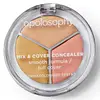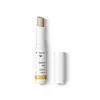What's inside
What's inside
 Key Ingredients
Key Ingredients

 Benefits
Benefits

 Concerns
Concerns

 Ingredients Side-by-side
Ingredients Side-by-side

Olea Europaea Fruit Oil
MaskingIsoamyl Laurate
EmollientCaprylic/Capric Triglyceride
MaskingSilica
AbrasiveCera Alba
EmollientMagnesium Silicate
AbsorbentCandelilla Cera
EmollientPrunus Armeniaca Kernel Oil
MaskingSimmondsia Chinensis Seed Oil
EmollientCopernicia Cerifera Cera
EmollientTocopherol
AntioxidantAscorbyl Palmitate
AntioxidantHydrogenated Lecithin
EmulsifyingHelianthus Annuus Seed Oil
EmollientAlumina
AbrasiveMagnesium Oxide
AbsorbentCI 77891
Cosmetic ColorantCI 77492
Cosmetic ColorantCI 77491
Cosmetic ColorantCI 77499
Cosmetic ColorantOlea Europaea Fruit Oil, Isoamyl Laurate, Caprylic/Capric Triglyceride, Silica, Cera Alba, Magnesium Silicate, Candelilla Cera, Prunus Armeniaca Kernel Oil, Simmondsia Chinensis Seed Oil, Copernicia Cerifera Cera, Tocopherol, Ascorbyl Palmitate, Hydrogenated Lecithin, Helianthus Annuus Seed Oil, Alumina, Magnesium Oxide, CI 77891, CI 77492, CI 77491, CI 77499
Simmondsia Chinensis Seed Oil
EmollientTapioca Starch
Ricinus Communis Seed Oil
MaskingOlea Europaea Fruit Oil
MaskingBeeswax
Emulsion StabilisingLanolin
EmollientElaeis Guineensis Oil
EmollientCaprylic/Capric Triglyceride
MaskingEuphorbia Cerifera Wax
Copernicia Cerifera Wax
Rosa Damascena Flower Extract
MaskingMica
Cosmetic ColorantParfum
MaskingDaucus Carota Sativa Root Extract
Skin ConditioningAnthyllis Vulneraria Extract
Skin ConditioningCalendula Officinalis Flower Extract
MaskingPrunus Armeniaca Kernel Oil
MaskingTocopherol
AntioxidantAscorbyl Dipalmitate
AntioxidantSilica
AbrasiveHelianthus Annuus Seed Oil
EmollientAlumina
AbrasiveMagnesium Oxide
AbsorbentIron Oxides
CI 77891
Cosmetic ColorantCI 77007
Cosmetic ColorantZinc Oxide
Cosmetic ColorantCitrus Aurantium Bergamia Peel Oil
Ant Egg Oil Extract
Lavandula Oil/Extract
Linalyl Acetate
MaskingLinalool
PerfumingLimonene
PerfumingSclareol
PerfumingPinene
MaskingTerpineol
MaskingBeta-Caryophyllene
MaskingGeranyl Acetate
PerfumingGeraniol
PerfumingCamphor
MaskingCoumarin
PerfumingCitral
PerfumingAlpha-Terpinene
PerfumingTerpinolene
PerfumingEugenol
PerfumingSimmondsia Chinensis Seed Oil, Tapioca Starch, Ricinus Communis Seed Oil, Olea Europaea Fruit Oil, Beeswax, Lanolin, Elaeis Guineensis Oil, Caprylic/Capric Triglyceride, Euphorbia Cerifera Wax, Copernicia Cerifera Wax, Rosa Damascena Flower Extract, Mica, Parfum, Daucus Carota Sativa Root Extract, Anthyllis Vulneraria Extract, Calendula Officinalis Flower Extract, Prunus Armeniaca Kernel Oil, Tocopherol, Ascorbyl Dipalmitate, Silica, Helianthus Annuus Seed Oil, Alumina, Magnesium Oxide, Iron Oxides, CI 77891, CI 77007, Zinc Oxide, Citrus Aurantium Bergamia Peel Oil, Ant Egg Oil Extract, Lavandula Oil/Extract, Linalyl Acetate, Linalool, Limonene, Sclareol, Pinene, Terpineol, Beta-Caryophyllene, Geranyl Acetate, Geraniol, Camphor, Coumarin, Citral, Alpha-Terpinene, Terpinolene, Eugenol
Ingredients Explained
These ingredients are found in both products.
Ingredients higher up in an ingredient list are typically present in a larger amount.
Alumina is another name for the compound aluminum oxide. It is used as a thickener, absorbent, and abrasive.
As an absorbent, alumina can give a mattifying effect. It is used in mineral sunscreens to help coat nano-sized filters, such as titanium dioxide. By increasing the size of the UV filters, these ingredients stay on the skin for a longer time. By coating small sized ingredients, alumina helps thicken a product.
Alumina may be used as an abrasive, or exfoliant.
Alumina is naturally occurring in the mineral corundum. Certain varieties of corundum create rubies and sapphires. Corundum is also the crystalline form of alumina.
Learn more about AluminaThis ingredient is an emollient, solvent, and texture enhancer. It is considered a skin-softener by helping the skin prevent moisture loss.
It helps thicken a product's formula and makes it easier to spread by dissolving clumping compounds.
Caprylic Triglyceride is made by combining glycerin with coconut oil, forming a clear liquid.
While there is an assumption Caprylic Triglyceride can clog pores due to it being derived from coconut oil, there is no research supporting this.
Learn more about Caprylic/Capric TriglycerideCi 77891 is a white pigment from Titanium dioxide. It is naturally found in minerals such as rutile and ilmenite.
It's main function is to add a white color to cosmetics. It can also be mixed with other colors to create different shades.
Ci 77891 is commonly found in sunscreens due to its ability to block UV rays.
Learn more about CI 77891Helianthus Annuus Seed Oil is the oil derived from the seeds of a Sunflower. Sunflower seed oil is non-fragrant. It is an emollient, meaning it helps to soften the skin.
Sunflower seed oil contains many fatty acids. The fatty acids found in sunflower seeds include (from highest amount to least): linoleic acid, myristic acid, palmitic acid, stearic acid, arachidic acid, oleic acid, and linolenic acid.
These fatty acids help the skin create ceramides. Ceramides play a role in repairing the skin barrier.
Helianthus Annuus Seed Oil helps moisturize the skin. This in turn helps the skin look more rejuvenated and smoother.
Sunflowers are rich in vitamin E.
Historians believe Indigenous cultures of North America domesticated sunflowers before corn. Thus they relied on sunflower oil for a variety of uses. One such use is moisturizing skin and hair.
Sunflower seed oil may not be fungal acne safe. We recommend speaking with a professional if you have any concerns.
Learn more about Helianthus Annuus Seed OilWe don't have a description for Magnesium Oxide yet.
Olea Europaea Fruit Oil is the fixed oil obtained from the ripe fruit of the Olive. In other words - olive oil.
The primary contents of olive oil are glycerides of the fatty acids linoleic, oleic and palmitic.
Olive oil also contains antioxidants such as Vitamin E. Antioxidants may help reduce signs of aging by fighting unstable free-radical molecules. It also contains Vitamins A (retinol), D, and K.
The squalene in olive oil makes it a great emollient. Emollients help soothe and soften your skin by trapping moisture in. This makes olive oil a great skin moisturizer.
Studies show olive oil to have antibacterial and antifungal properties in low concentrations. Another study found olive oil irritated sensitive oily skin. We always recommend speaking with a professional about using this ingredient in your routine.
Due to the fatty acid content, this ingredient may not be fungal-acne safe.
Learn more about Olea Europaea Fruit OilThis ingredient is the oil from the apricot.
Apricot Kernel Oil is an emollient and helps soften skin. This is due to its fatty acid components. Some of these fatty acids include linoleic and oleic acid.
This ingredient also has antioxidant properties from Vitamins A, C, and E. Antioxidants help fight free-radicals. Free-radicals are molecules that may damage your skin cells. Besides being antioxidants, these vitamins provide plenty of skin benefits as well.
Learn more about Prunus Armeniaca Kernel OilSilica, also known as silicon dioxide, is a naturally occurring mineral. It is used as a fine, spherical, and porous powder in cosmetics.
Though it has exfoliant properties, the function of silica varies depending on the product.
The unique structure of silica enhances the spreadability and adds smoothness, making it a great texture enhancer.
It is also used as an active carrier, emulsifier, and mattifier due to its ability to absorb excess oil.
In some products, tiny microneedles called spicules are made from silica or hydrolyzed sponge. When you rub them in, they lightly polish away dead skin layers and enhance the penetration of active ingredients.
Learn more about SilicaThis oil comes from the seeds of the desert shrub called Jojoba. It is more commonly known as jojoba oil, a non-comedogenic oil.
Jojoba oil does not contain fragrance and has many fatty-acids, making it a great soothing ingredient.
It also contains Vitamin E, a great moisturizing ingredient. Vitamin E is also an antioxidant and protects your skin against oxidative damage.
This ingredient humectant properties, meaning it helps draw moisture from the air. This helps keep your skin hydrated.
While jojoba has antibacterial properties, it is only able to kill some strains of bacteria.
Studies also show it helps in wound healing. In fact, Indigenous cultures have used jojoba as a moisturizer and to help treat burns for centuries.
Fun fact: Jojoba oil similar to natural human skin sebum, so it has a great effect on dry skin. It is also promising with helping to regulate sebum production.
Due to its fatty acid content, Jojoba oil may not be fungal acne safe. We recommend speaking with a professional if you have any concerns.
Learn more about Simmondsia Chinensis Seed OilTocopherol (also known as Vitamin E) is a common antioxidant used to help protect the skin from free-radicals and strengthen the skin barrier. It's also fat soluble - this means our skin is great at absorbing it.
Vitamin E also helps keep your natural skin lipids healthy. Your lipid skin barrier naturally consists of lipids, ceramides, and fatty acids. Vitamin E offers extra protection for your skin’s lipid barrier, keeping your skin healthy and nourished.
Another benefit is a bit of UV protection. Vitamin E helps reduce the damage caused by UVB rays. (It should not replace your sunscreen). Combining it with Vitamin C can decrease sunburned cells and hyperpigmentation after UV exposure.
You might have noticed Vitamin E + C often paired together. This is because it is great at stabilizing Vitamin C. Using the two together helps increase the effectiveness of both ingredients.
There are often claims that Vitamin E can reduce/prevent scarring, but these claims haven't been confirmed by scientific research.
Learn more about Tocopherol